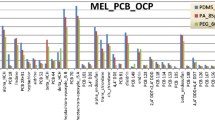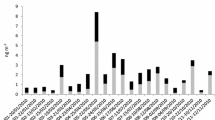Abstract
Gas chromatographic analysis of polybrominated diphenyl ethers (PBDEs) has been evaluated in an attempt to achieve better control of the separation process, especially for highly substituted congeners. Use of a narrow-bore capillary column enabled adequate determination of tetra, penta, hexa, hepta, octa, nona and decaBDE congeners in only one chromatographic run while maintaining resolution power similar to that of conventional columns. A micro electron-capture detector (GC–μECD) was used. Chromatographic conditions were optimized by multifactorial experimental design, with the objective of obtaining not only high sensitivity but also good precision. In this way two different approaches to maximizing response and minimizing variability were tested, and are fully discussed. These optimum chromatographic conditions were then used to determine PBDEs extracted from domestic dust samples by microwave-assisted solvent extraction (MASE). Quantitative recovery (90–108%) was achieved for all the PBDEs and method precision (RSD < 13%) was satisfactory. Accuracy was tested by use of the standard reference material SRM 2585, and sub-ng g−1 limits of detection were obtained for all compounds except BDE-209 (1.44 ng g−1). Finally, several samples of house dust were analysed by use of the proposed method and all the target PBDEs were detected in all the samples. BDE-209 was the predominant congener. Amounts varied from 58 to 1615 ng g−1 and the average contribution to the total PBDE burden of 52%. The main congeners of the octaBDE mixture (BDE-183, BDE-197, BDE-207 and BDE-196) also made an important contribution (29%) to the total. These are the first data about the presence of these compounds in European house-dust samples. Finally, the sum of the main congeners in the pentaBDE commercial mixture (BDE-47, BDE-99, and BDE-100) contributed 14% to the total.

Polybrominated diphenyl ethers in House Dust








Similar content being viewed by others
References
World Health Organization-International Programme on Chemical Safety (1994) Environmental health criteria 162: brominated diphenyl ethers. Geneva, Switzerland (see http://www.inchem.org/documents/ehc/ehc/ehc162.htm)
Bromine Science and Environmental Forum (2003) Major brominated flame retardants volume estimates (see http://www.bsefsite.com/docs/bfr_vols_2001.doc)
Agency for Toxic Substances and Disease Registry (2004) Toxicological profile for polybrominated biphenyls and polybrominated diphenylethers. U.S. Department of Health and Human Services (see http://www.atsdr.cdc.gov/toxprofiles/tp68.pdf)
Sjödin A, Päpke O, McGahee E, Jones R, Focant JF, Pless-Mulloli T, Toms LM, Wang R, Zhang Y, Needham L, Herrmann T, Patterson D (2004) Organohal Compd 66:3817–3822
Environ International Corporation (2003) Tier 1 Assessment of the potential health risks to children associated with exposure to the commercial pentabromodiphenyl ether product. Voluntary Children’s Environmental Exposure Program Pilot (VCEEPP). Prepared by ENVIRON International Corporation for Great Lakes Chemical Corporation
Elliott JE, Wilson LK, Wakeford B (2005) Environ Sci Technol 39:5584–5591
Faengstroem B, Hovander L, Bignert A, Athanassiadis I, Linderholm L, Grandjean P, Weihe P, Bergman A (2005) Environ Sci Technol 39:9457–9463
Watanabe I, Tatsukawa R (1987) Bull Environ Contam Toxicol 39:953–959
Sellström U, Söderström G, de Wit C, Tysklind M (1998) Organohal Compd 35:447–450
Peterman PH, Orazio CE, Feltz KP (2003) Organohal Compd 63:357–360
Tysklind M, Sellström U, Söderström G, de Wit C (2001) Abiotic transformation of polybrominated diphenylethers (PBDEs): Photolytic debromination of decabromo diphenyl ether. Brominated Flame Retardants Conference, Ontario, Canada, pp, 42–45
de Boer J, Cofino WP (2002) Chemosphere 46:625–633
de Boer J (2004) Environ Chem 1:81–85
Korytár P, Covaci A, de Boer J, Gelbin A (2005) J Chromatogr A 1065:239–249
Björklund J (2003) Gas chromatography and mass spectrometry of polybrominated diphenyl ethers. Ph. D. Thesis, Department of Analytical Chemistry, Stockholm University, Stockholm, Sweden
Covaci A, de Boer J, Ryan JJ, Voorspoels S, Schepens P (2002) Anal Chem 74:790–798
Alaee M, Sergeant DB, Ikonomou MG, Luross JM (2001) Chemosphere 44:1489–1495
de Boer J, Allchin C, Law R, Zegers B, Boon JP (2001) Trends Anal Chem 20:591–599
Björklund J, Tollbäck P, Hiärne C, Dyremark E, Östman C (2004) J Chromatogr A 1041:201–210
Sjödin A, Carlsson H, Thuresson K, Sjölin S, Bergman Å, Östman C (2001) Environ Sci Technol 35:448–454
Vetter W (2001) Anal Chem 73:4951–4957
Polo M, Gómez-Noya G, Quintana JB, Llompart M, García-Jares C, Cela R (2004) Anal Chem 76:1054–1062
Pirard C, de Pauw E, Focant JF (2003) J Chromatogr A 998:169–181
de Boer J, Allchin CR (2001) Organohal Compd 52:13–17
Allchin CR, Law RJ, Morris S (1999) Environ Poll 105:197–207
Hanari N, Okazawa T, Guruge K, Falandysz J, Yamashita N (2004) Organohal Compd 66:205–210
Martínez A, Ramil M, Montes R, Hernanz D, Rubí E, Rodríguez I, Cela R (2005) J Chromatogr A 1072:83–91
Jones-Otazo HA, Clarke JP, Diamond ML, Archbold JA, Ferguson G, Harner T, Richardson GM, Ryan JJ, Wilford B (2005) Environ Sci Technol 39:5121–5130
Wilford BH, Shoeib M, Harner T, Zhu J, Jones AK (2005) Environ Sci Technol 39:7027–7035
Santillo D, Johnston P, Brigden K (2001) The presence of brominated flame retardants and organotin compounds in dusts collected from Parliament buildings from eight countries. Greenpeace Research Laboratories, Exeter University, UK (see http://www.greenpeace.to/publications_pdf/dust%2003_2001.pdf)
Knoth W, Mann W, Meyer R, Nebhuth J (2002) Organohal Compd 58:213–216
Julander A, Westberg H, Engwalla M, van Bavel B (2005) Sci Total Environ 350:151–160
Rudel RA, Camann DE, Spengler JD, Korn LR, Brody JG (2003) Environ Sci Technol 37:4543–4553
Stapleton HM, Dodder NG, Offenberg JH, Schantz MM, Wise S (2005) Environ Sci Technol 39:925–931
Regueiro J, Llompart M, García-Jares C, Cela R (2006) J Chromatogr A 1137:1–7
Tan J, Cheng SM, Loganath A, Chong YS, Obbard JP (2007) Chemosphere 66:985–992
Saito K, Sjödin A, Sandau CD, Davis MD, Nakazawa H, Matsuki Y, Patterson DG Jr (2004) Chemosphere 57:373–381
KemmLein S, Bergmann M, Jann O, Wurbs J, Eggers HH (eds) (2005) Standard measurement method for the determination of polybrominated flame retardants (pentabromo diphenylether, octabromo diphenylether) in products. Federal Environmental Agency (Umweltbundesamt), Berlin, Germany
Stapleton HM, Harner T, Shoeib M, Keller JM, Schantz MM, Leigh SD, Wise SA (2006) Anal Bioanal Chem 384:791–800
Acknowledgement
This research was financed by FEDER funds and by projects CTQ2006-03334 from the CICYT (Ministerio de Ciencia y Tecnología, Spain) and PGIDIT04PXIC23701PN from Xunta de Galicia. J.R. acknowledges receipt of a doctoral grant from the CICYT.
Author information
Authors and Affiliations
Corresponding author
Rights and permissions
About this article
Cite this article
Regueiro, J., Llompart, M., Garcia-Jares, C. et al. Factorial-design optimization of gas chromatographic analysis of tetrabrominated to decabrominated diphenyl ethers. Application to domestic dust. Anal Bioanal Chem 388, 1095–1107 (2007). https://doi.org/10.1007/s00216-007-1350-8
Received:
Revised:
Accepted:
Published:
Issue Date:
DOI: https://doi.org/10.1007/s00216-007-1350-8




